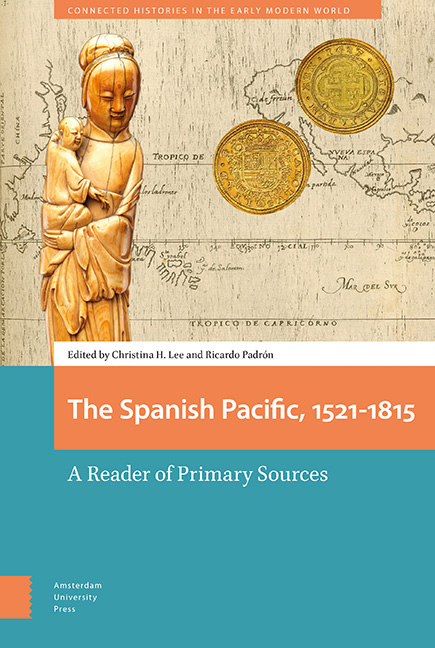Book contents
- Frontmatter
- Contents
- Abbreviations
- Acknowledgements
- Introduction
- 1 An Early Transpacific Account of the Spice Islands by Andrés de Urdaneta (1536)
- 2 Domingo de Salazar’s Letter to the King of Spain in Defense of the Indians and the Chinese of the Philippine Islands (1582)
- 3 Juan Cobo’s Map of the Pacific World (1593)
- 4 A Royal Decree of Philip III Regulating Trade between the Philippines and New Spain (1604)
- 5 Manila’s Sangleys and a Chinese Wedding (1625)
- 6 Don Luis Castilla Offers to Sell Land in Manila (1629)
- 7 Idolatry and Apostasy in the 1633 Jesuit Annual Letter
- 8 The Will of an Indian Oriental and her Chinos in Peru (1644
- 9 Francisco de Combés’s History of Mindanao and Jolo (1667)
- 10 Between Fiction and History in the Spanish Pacific The Misfortunes of Alonso Ramírez (1690)
- 11 A Moluccan Crypto-Muslim before the Transpacific Inquisition (1623–1645)
- 12 Constitutions and Rules of the Beatas Indias (1726)
- 13 The Poetics of Praise and the Demands of Confession in the Early Spanish Philippines: Notes and Documents
- 14 The Pacific Theater of the Seven Years’ War in a Latin Poem by an Indigenous Priest, Bartolomé Saguinsín (1766)
- 15 A Prohibition on Digging Up the Bones of the Dead (1813)
- Index
Introduction
Published online by Cambridge University Press: 20 November 2020
- Frontmatter
- Contents
- Abbreviations
- Acknowledgements
- Introduction
- 1 An Early Transpacific Account of the Spice Islands by Andrés de Urdaneta (1536)
- 2 Domingo de Salazar’s Letter to the King of Spain in Defense of the Indians and the Chinese of the Philippine Islands (1582)
- 3 Juan Cobo’s Map of the Pacific World (1593)
- 4 A Royal Decree of Philip III Regulating Trade between the Philippines and New Spain (1604)
- 5 Manila’s Sangleys and a Chinese Wedding (1625)
- 6 Don Luis Castilla Offers to Sell Land in Manila (1629)
- 7 Idolatry and Apostasy in the 1633 Jesuit Annual Letter
- 8 The Will of an Indian Oriental and her Chinos in Peru (1644
- 9 Francisco de Combés’s History of Mindanao and Jolo (1667)
- 10 Between Fiction and History in the Spanish Pacific The Misfortunes of Alonso Ramírez (1690)
- 11 A Moluccan Crypto-Muslim before the Transpacific Inquisition (1623–1645)
- 12 Constitutions and Rules of the Beatas Indias (1726)
- 13 The Poetics of Praise and the Demands of Confession in the Early Spanish Philippines: Notes and Documents
- 14 The Pacific Theater of the Seven Years’ War in a Latin Poem by an Indigenous Priest, Bartolomé Saguinsín (1766)
- 15 A Prohibition on Digging Up the Bones of the Dead (1813)
- Index
Summary
The “Spanish Pacific” designates the space Spain colonized or aspired to rule in Asia between 1521, the year Ferdinand Magellan reached the East by sailing west, and 1815, the year when the annual galleon that linked Mexico to the Philippines stopped operating. The Spanish Pacific encompasses the area in Asia that Spanish officials willfully called “the Indies of the West,” in order to clarify that they were not “the Indies of the East,” and, therefore, not Portuguese. It includes the Philippines and the Marianas—territories ruled by the Spanish Crown—but also parts of China, Japan, and other parts of Asia that Spanish officials and missionaries imagined as extensions of their American colonies (Fig. I.1).
The study of the early modern Spanish Pacific was once the exclusive purview of Philippine studies, the history of exploration, and economic history, but over the course of the past few decades, it has attracted interest from Latin American studies, Sinology, and Hispanic studies, as well as other fields. This reader is meant to support this expansion of interest, by providing a varied collection of primary sources, translated into English, that can be incorporated into existing course syllabi in a variety of disciplines, at the graduate and undergraduate level. It is the collective work of a group of scholars in Spanish Pacific studies who participated in an interdisciplinary symposium held at Princeton University in April of 2018. Each participant was asked to pick a text that illuminated a vital area of contemporary research, to transcribe, edit, and translate it, and to provide a general introduction for his or her selection. As a result, the collection provides a snapshot of the field as understood by the participants in the symposium, rather than a documentary history of the Spanish Pacific. It leaves many bases uncovered, but only so that it can push against the boundaries of the field as it has been conventionally understood.
This introduction provides an overview of Spanish Pacific studies as the editors of this volume understand it, and situates The Spanish Pacific reader within this emerging field.
- Type
- Chapter
- Information
- Spanish Pacific, 1521–1815A Reader of Primary Sources, pp. 11 - 20Publisher: Amsterdam University PressPrint publication year: 2020



